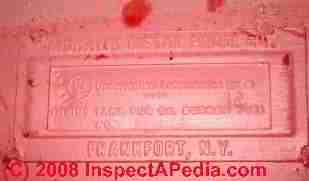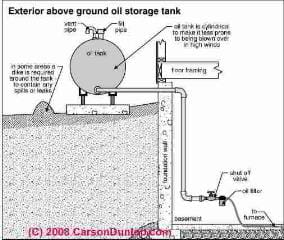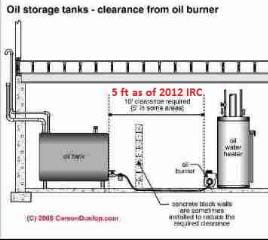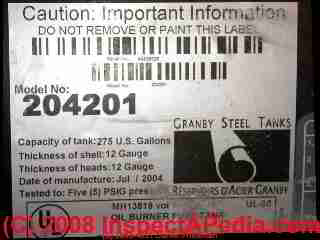 OIL TANK STANDARDS - Above Ground [Heating Oil] Storage Tanks
OIL TANK STANDARDS - Above Ground [Heating Oil] Storage Tanks
UL Oil Tank Standards & Oil Tank Listing Requirements
- POST a QUESTION or COMMENT about oil storage tank standards for construction & testing
A New Underwriters Laboratory (UL) Listing Service covers entire aboveground storage tank systems.
InspectAPedia tolerates no conflicts of interest. We have no relationship with advertisers, products, or services discussed at this website.
Oil Storage Tank Standards for Tank Construction & Tank Testing
Subject 2244, Aboveground Flammable Liquid Tank Systems
 For years, factory-fabricated aboveground liquid storage tanks such as those used to store home heating oil
were shipped to job sites where dispensers, flame arrestors, vents and other accessories were added. Installers verified that the proper components were selected for compliance with fire and environmental codes.
For years, factory-fabricated aboveground liquid storage tanks such as those used to store home heating oil
were shipped to job sites where dispensers, flame arrestors, vents and other accessories were added. Installers verified that the proper components were selected for compliance with fire and environmental codes.
[Click to enlarge any image]
Unfortunately, code authorities still might find that requirements were not met. Sketch of an above ground outdoor oil storage tank is courtesy of Carson Dunlop Associates, a Toronto home inspection, education & report writing tool company [ carsondunlop.com ].
During the past five years, manufacturers have introduced complete aboveground storage tank (AST) systems with related accessories, such as dispensers, siphon valves, overfill protection systems and emergency venting devices, installed on the tank at the factory.
Authorities Having Jurisdiction (AHJs) and manufacturers have requested that UL investigate entire factory-fabricated AST systems, to streamline the field-approval process and minimize problems associated with incompatible tank accessories.
UL has established a new product category and continues outlining requirements for Subject 2244, Aboveground Flammable Liquid Tank Systems. UL has already completed its first product Listings to Subject 2244, and work on a proposed Standard was expected to begin in 1998.
 Subject 2244 identifies four AST installations: aviation-fuel storage, motor-vehicle fuel dispensing, motor-oil storage, and generator-base tank systems.
Subject 2244 identifies four AST installations: aviation-fuel storage, motor-vehicle fuel dispensing, motor-oil storage, and generator-base tank systems.
AST systems include a primary tank with integral secondary containment, provided by a double-wall tank or an integral tank and dike. Required and optional components are assembled prior to shipping.
However, some components may require limited field assembly detailed in the installation instructions provided with each AST system.Sketch of an indoor above ground oil storage tank is courtesy of Carson Dunlop Associates, a Toronto home inspection, education & report writing tool company [ carsondunlop.com ].
To assist code authorities in facilitating the field evaluation process, UL has developed a Code Compliance Verification List (CCVL) for UL Listed AST systems.
The CCVL documents how the tank complies with U.S. model codes, including National Fire Protection Association (NFPA) 30, Flammable and Combustible Liquids, and NFPA 30A, Automotive and Marine Service Stations, and the Uniform Fire Code (UFC). The CCVI, is included with UL Listed AST systems, and will be provided in the guide card information for Aboveground Flammable Liquid Tanks (ECRU) in the 1998 edition of ULs Gas and Oil Directory (gray book).
The CCVL identifies the model code requirements for AST installations, including: supports, venting, piping and fittings, tank construction and openings, electrical installations, spill-control dispensers, and other accessories. The CCVL also documents installed components, including manufacturers' names, model numbers, ratings and UL Listing information.
 For example, motor-vehicle fuel-dispensing tank systems have requirements for sizing emergency vents in accordance with the exposed side walls and top of tank. The CCVL documents the required emergency venting for the tank, and identifies that the appropriately sized UL Listed emergency vent was installed.
For example, motor-vehicle fuel-dispensing tank systems have requirements for sizing emergency vents in accordance with the exposed side walls and top of tank. The CCVL documents the required emergency venting for the tank, and identifies that the appropriately sized UL Listed emergency vent was installed.
The UL Listing markings on a tank system will identify the primary tank construction, For example, UL 142 and Subject 2244 indicate a steel tank; UL 2085 and Subject 2244 indicate a protected-tank system.
UL markings affixed to ASTs that have been evaluated to Subject 2244 will also include the AST system type, such as motor-vehicle fuel dispensing, generator-base, aviation-fuel storage and motor-oil storage.
For more information regarding UL requirements for aboveground flammable liquid tank systems, contact UL engineer Shari Duzac in Santa Clara, Calif., by telephone at (408) 985-2400, ext. 32550; by fax at (408) 556-6036; or by e-mail at duzacs@ul.com.
Source: The Code Authority, Underwriters Laboratories -- December 1997
UL-142 Standard as Amended in July 1998
UL-142 oil storage tank standard Amendment 1 1998 - Steel Aboveground Tanks for Flammable and Combustible Liquids, 7th Ed, was released on 22 July 1998 and replaced or amended older versions of UL Standard 142. UL's comments about the new standard included these remarks:
These requirements cover steel atmospheric tanks intended for aboveground storage of noncorrosive, stable flammable, and combustible liquids that have a specific gravity not exceeding that of water.
These tanks are intended for installation and use in accordance with the Flammable and Combustible Liquids Code, NFPA 30; the Standard for Installation of Oil Burning Equipment, NFPA 31; and the Automotive and Marine Service Station Code, NFPA 30A.
Tanks covered by these requirements are fabricated, inspected and tested for leakage before shipment from the factory as completely assembled vessels.
These requirements do not cover seismic loading.
Geometries or special constructions not specifically covered in these requirements shall be investigated on an individual basis.
A product that contains features, characteristics, components, materials, or systems new or different from those in use when the Standard was developed, and that involves a risk of fire, electric shock, or injury to persons, shall be evaluated using the appropriate additional component and end-product requirements as determined necessary to mai ntain the level of safety for the user of the product as originally anticipated by the intent of this Standard.
Pressure Testing Guidelines for Oil Storage Tanks
UL-142 oil storage tank standard calls for pressure testing oil storage tanks (that fall under this standard) at 3-5 psi for cylindrical oil storage tanks.
UL-142 calls for pressure testing oil storage tanks (that fall under this standard) at 1.5-2 psi for rectangular welded-construction storage tanks.
Bench top above ground storage tanks for flammable and combustible liquids (Standard UL 142) also must meet NFPA setions 30, 30A, 31 and the Uniform Fire Code UFC Article 79. These benchtop atmospheric tanks are typically tested to 1 psi but may have to have passed a design hydrostatic pressure tes of 25 psi.
Other types of tanks such as double wall generator base tanks might be tested to 25 psi and at four times load pressure test.
These complete text of these oil storage tank codes and standards are available from UL, NFPA, and ASTM directly.
Oil Tank Construction and Testing Standards
UL-142 Standard for Steel Aboveground Tanks for Flammable and Combustible Liquids
This standard whose roots date to 1922, covers steel atmospheric pressure tanks used above ground to store non-corrosive, stable flammable, and combustible liquids which are no more dense than water. For example this would include No2. heating oil used at residential properties.
These tanks are required to be installed in accordance with:
- NFPA 30 - the Flammable and Combustible Liquids Code
- NFPA-31 - the Standard for Installation of Oil-Burning Equipment
- NFPA 30A - the Motor Fuel Dispensing Facilities and Repair garages code
- The Uniform Fire Code - published by IFCI the International Fire Code Institute
These complete text of these oil storage tank codes and standards are available from UL, NFPA, and ASTM directly.
Other tank codes that do not pertain to oil tanks built to UL-142 include:
- Seismic loading effects on oil storage tanks are not considered by UL-142
- Specially-constructed oil storage tanks are not considered by UL-142
- API-650 - standard for Welded Steel Tanks for Oil Storage
- API-12D - Specification for Field-Welded Tanks for Storage of Production Liquids
- API-12F - Specification for Shop-Welded Tanks for Storage of Production Liquids
U.S. Environmental Protection Agency EPA Underground Oil Storage Tank Regulations include - Complete 40 CFR part 280 Technical Standards and Corrective Action Requirements for Owners and Operators of Underground Storage Tanks (UST) (454K byte PDF). This document defines dielectric material (coatings) used to protect underground oil storage tanks from corrosion:
More about the galvanic scale and corrosion between dissimilar metals is at GALVANIC SCALE & METAL CORROSION.
...
Continue reading at OIL TANK CODES & STANDARDS or select a topic from the closely-related articles below, or see the complete ARTICLE INDEX.
Or see these
Recommended articles
Suggested citation for this web page
OIL TANK STANDARDS - UL at InspectApedia.com - online encyclopedia of building & environmental inspection, testing, diagnosis, repair, & problem prevention advice.
Or see this
INDEX to RELATED ARTICLES: ARTICLE INDEX to HEATING OIL, OIL BURNERS, OIL FIRED HEATERS, OIL TANKS
Or use the SEARCH BOX found below to Ask a Question or Search InspectApedia
Ask a Question or Search InspectApedia
Questions & answers or comments about oil storage tank standards for manufacture, testing, installation, maintenance & repair. .
Try the search box just below, or if you prefer, post a question or comment in the Comments box below and we will respond promptly.
Search the InspectApedia website
Note: appearance of your Comment below may be delayed: if your comment contains an image, photograph, web link, or text that looks to the software as if it might be a web link, your posting will appear after it has been approved by a moderator. Apologies for the delay.
Only one image can be added per comment but you can post as many comments, and therefore images, as you like.
You will not receive a notification when a response to your question has been posted.
Please bookmark this page to make it easy for you to check back for our response.
Our Comment Box is provided by Countable Web Productions countable.ca
Citations & References
In addition to any citations in the article above, a full list is available on request.
- Mark Cramer Inspection Services Mark Cramer, Tampa Florida, Mr. Cramer is a past president of ASHI, the American Society of Home Inspectors and is a Florida home inspector and home inspection educator. Mr. Cramer serves on the ASHI Home Inspection Standards. Contact Mark Cramer at: 727-595-4211 mark@BestTampaInspector.com
- John Cranor [Website: /www.house-whisperer.com ] is an ASHI member and a home inspector (The House Whisperer) is located in Glen Allen, VA 23060. He is also a contributor to InspectApedia.com in several technical areas such as plumbing and appliances (dryer vents). Contact Mr. Cranor at 804-873-8534 or by Email: johncranor@verizon.net
- NFPA - the National Fire Protection Association can be found online at www.nfpa.org
- Thanks to Denise Adjutant, DOIT Web Support Division 271-8173, for New Hampshire oil tank regulations link update 6/22/09 Denise.Adjutant@doit.nh.gov
- Canadian oil tank regulations sources include the individual provincial government websites and the Canadian Technical Standards and Safety Authority, 14th Floor, Centre Tower, 3300 Bloor Street West, Toronto, Ontario M8X 2X4 - http://www.tssa.org/ Contact the Canadian TSSA toll free at 1-877-682-TSSA (8772) or 416-734-3300 for the Toronto area. The Technical Standards and Safety Authority (TSSA) is an independent, not-for-profit organization responsible for the delivery of a range of safety services. This includes the administration of Ontario’s Technical Standards & Safety Act, 2000 within various industry sectors and the delivery of safety programs to the public.
- The distance requirements for oil tanks to be set back from wells, property lines, etc. can be read at WELL CLEARANCES
- Our recommended books about building & mechanical systems design, inspection, problem diagnosis, and repair, and about indoor environment and IAQ testing, diagnosis, and cleanup are at the InspectAPedia Bookstore. Also see our Book Reviews - InspectAPedia.
- Oil Tanks - The Oil Storage Tank Information Website: Buried or Above Ground Oil Tank Inspection, Testing, Cleanup, Abandonment of Oil Tanks
- Abandon a Buried Oil Tank, How To - Abandoning Commercial Underground Tanks, Russ Brauksieck, ASHI Tech. Journal, Vol.3 No.1 Spring 1993, P. 40-41 [Reprint]
- Above Ground Oil Tanks: Visual Inspection of Oil Storage Tanks for evidence of leaks, damage, improper piping - photos and text
- Above Ground Oil Tanks Checklist, an Oil Company's advice
- Above Ground Tanks UL Standards, UL Tank Listing Standards, guidance for home owners, buyers, and inspectors
- Buried Oil Tanks - Finding How to Find Buried Oil Tanks and "Nearly Hidden" and Leaky Oil Tanks - photos and text.
- Buried Fuel tank - Advice - Buried FUEL Tank - GAS or OIL advice for home buyers, inspection report language
- Environmental Issues & Regulations for Oil Tanks, Registration, Abandonment, Leak Reporting
- Home Inspection Report Language Library: Buried Oil Tanks, Basic home buyer advice - home inspection report language suggestions
- Home Inspection Report Language Library: Visible Defects in Oil Tank Installations, Tanks, and Heating Oil Piping
- Home Inspection Report Language Library: Gas Fuel Piping or Tank Faults Basic advice - home inspection report language suggestions
- Home Inspection Report Language Library: Oil Tanks text file list © Oil and Other Storage Tank Leaks, Testing, Abandonment, Inspection - UST home inspection report language files - Reference List
- Indoor Environment Website Indoor Building Environmental Hazard Detection, Testing, Repair, & Prevention - Main Web Page
- Leaky Heating Oil Tanks - Advice for Home Owners or Buyers: caused of leaks in oil tanks, oil tank testing alternatives, what to do about leaky tanks: D.J. Friedman, ASHI Tech. Journal, Vol.2 No.1, Winter, 1992 p. 42-43 Illus
- Leak or Failure Rates for Home Heating Oil Tanks
- Legal Issues Regarding Buried Oil Storage Tanks K.S. Rea, Attorney, summary from ASHI Chapter Seminar.
- Primer on Petroleum Bulk Storage Tanks & Petroleum Contamination of Property Paul H. Ciminello, ASHI Tech. Journal, Vol.3 No.1 Spring 1993, p 35-39
- Petroleum Bulk Storage J. Sibblies, NY State DEC, Advice to Home Owners and Home Inspectors about Oil Storage Tanks - summary from ASHI Chapter Seminar.
- Septic Tank inspection, testing, diagnosis, repair
- OIL TANK LEAK / FAILURE CAUSES - Oil Tank Failure Causes - oil tank leaks are caused by corrosion, damage, soil conditions, other factors
- TANK FAILURE RATES - Oil Tank Failure Rates - Oil Tank Leak Probability as a Function of Tank Age, Location, Condition, Soil Conditions and Other Factors
- OIL TANK LEAK TEST METHODS - - How Oil Tanks are Tested for Evidence Leaks, of Current or Previous Oil Spills
- In addition to citations & references found in this article, see the research citations given at the end of the related articles found at our suggested
CONTINUE READING or RECOMMENDED ARTICLES.
- Carson, Dunlop & Associates Ltd., 120 Carlton Street Suite 407, Toronto ON M5A 4K2. Tel: (416) 964-9415 1-800-268-7070 Email: info@carsondunlop.com. Alan Carson is a past president of ASHI, the American Society of Home Inspectors.
Thanks to Alan Carson and Bob Dunlop, for permission for InspectAPedia to use text excerpts from The HOME REFERENCE BOOK - the Encyclopedia of Homes and to use illustrations from The ILLUSTRATED HOME .
Carson Dunlop Associates provides extensive home inspection education and report writing material. In gratitude we provide links to tsome Carson Dunlop Associates products and services.

